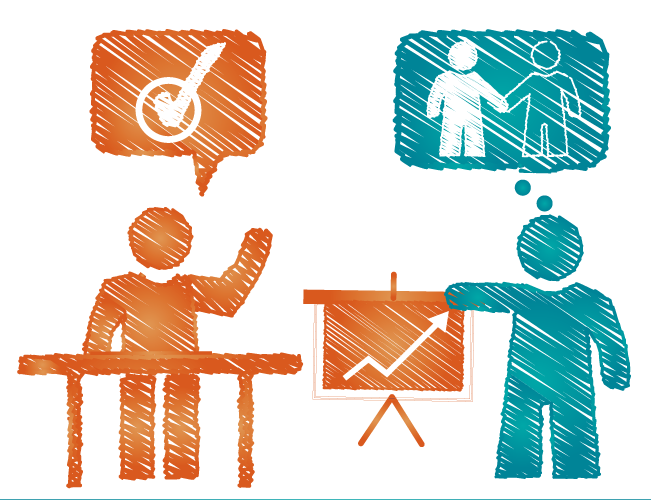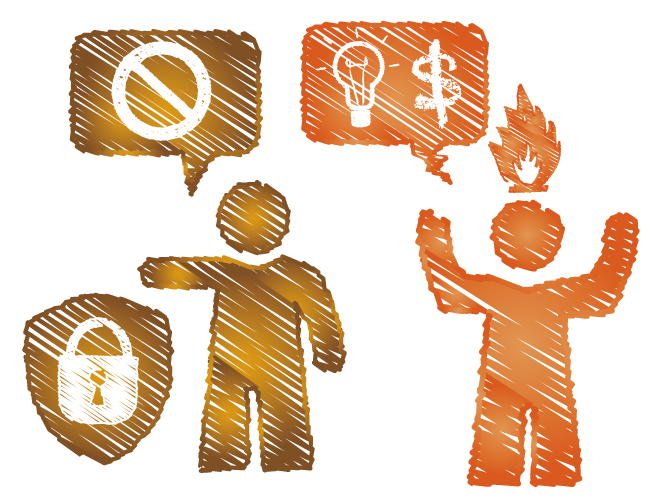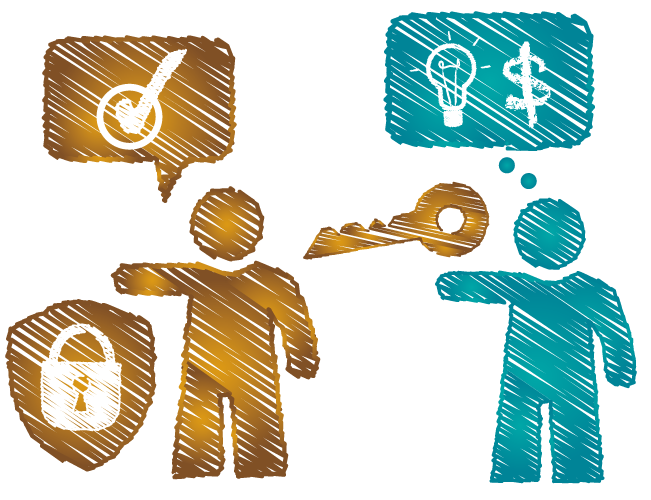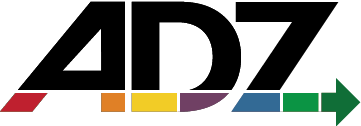Levels
The values of societies and organizations evolve over time in predictable patterns. Understanding those patterns helps us to see how we can align a diverse group of people and teams with various priorities, toward the same goals.
USE LEVELS TO SPEAK TO THE NEEDS AND VALUES OF YOUR LISTENER
Orange prioritizes achievement and excellence, while Green prioritizes conscious impact and accountability

A Green coach wants a change that will increase morale. The Orange leader can’t see how this will boost profits or performance and dismisses the idea.

The Integral coach speaks Orange achievement oriented language, and took the time to calculate the boost to throughput a morale increase would provide.
Orange prioritizes wealth and innovation, while Amber prioritizes security and stability

A Orange PO wants to release an innovative feature that will delight their customers. The Amber risk officer blocks the idea due to their reliance on a legacy process.

A Orange PO wants to release an innovative feature that will delight their customers. The Amber risk officer blocks the idea due to their reliance on a legacy process.
Orange prioritizes progress and success, while Amber prioritizes rules and processes

An Amber architect is frustrated that an Orange team leader allows their team to release code without the proper documentation.

The Integral architect streamlines the documentation process and makes it a tool that supports the Orange team’s achievement goals.
Learning how to speak to the needs of people with different values will help you to interact with them in a way that creates buy-in and aligns everyone’s goals to a common purpose.
Orgs ignore culture because they lack the tools to address it. Align your orgs various cultures using Integral theory's Levels of Development."
When organizations address the full range of values based needs, people, teams, and organizations will be the healthiest version of themselves, more capable of demonstrating their highest potential.
The things they VALUE are external expressions of their priorities. These are things organizations can provide in order to help satisfy these needs throughout the organization.
The NEEDS answer the question why this group values what they do.
If people express these values, provide these needs. If an organization provides the fullest range of values, then people will be healthy and they will be at their best. Coincidentally this also maps out exactly how you align people's goals toward a common purpose, which is by including, or speaking to the things they value, which are their priorities.

Harmony (Turquoise)
Turquoise is currently a vision of the possible future of our world.
Healthy: By being our best selves we can be true to others.
Unhealthy: There is no wrong way to be in the world.
WHAT TURQUOISE VALUES: Fluid structures and adaptation. Integration through harmony. Turquoise organizations take responsibility for the broader ecosystem they are a part of.
WHAT TURQUOISE NEEDS: fulfillment & harmony. Turquoise activities create value, meaning, while being connected to purpose.
EXAMPLES: Turquoise are integral parts of the ecosystems they inhabit (vendor/supplier ecosystems, communities, physical environments of their locations, etc.). Leaders may serve as guides, and teams are capable of reallocating their resources, including themselves, to address the needs of the whole.
Integral (Teal)
Teal is an emergent, and it has only recently begun to influence the cultures of our world.
Healthy: Diverse perspectives can be valuable when they are brought together in a healthy way.
Unhealthy: We are all valuable, but I am more valuable because only I can see it.
WHAT TEAL VALUES:
Alignment, wholeness, and diversity. Teal organizations value the wellbeing of customers and employees and recognize that they are part of a broader ecosystem.
WHAT TEAL NEEDS:
Purpose & alignment. An integration of all of the other Levels.
EXAMPLES:
Teal may demonstrate a high degree of autonomy and diversity, but they balance their tensions using an alignment of purpose rather than using power to force compliance or a shared identity to control others.
Relational (Green)
Healthy: We should consider our impact on everyone at every point along the way.
Unhealthy: Everyone should have an equal say in everything.
WHAT GREEN VALUES: Connectedness & accountability. Green looks not only at its impact on those around it, but also at the consequences of its choices and their impacts on people far removed.
WHAT GREEN NEEDS
Collective achievement and meaningful impact on others. A positive reputation or legacy. Reputation is similar to the pursuit of status we see with Red but here Green wants a meaningful positive impact on others.
EXAMPLES: An emphasis on stakeholder value, customer well-being, and sharing risks, profits, and ownership with employees. They often face the challenge of being flatter structures distributed across many regions and even countries.
Achievement (Orange)
Healthy: We all have value. Let me prove mine.
Unhealthy: “Greed is good.”
WHAT ORANGE VALUES: Success, excellence and differentiation, proving my individual differences are valuable. Ability to innovate.
WHAT ORANGE NEEDS: Personal growth and opportunities for achievement.
EXAMPLES: Merit-based incentives can drive people to be their best, and lead to the best people to rise to excellence, but profiting at the expense of others might be viewed as rewards that are deserved because they were earned.
Structural (Amber)
Healthy: Success comes from managing our exposure to risk.
Unhealthy: Change = risk.
WHAT AMBER VALUES: Conformity, security, minimizing risk, rules and order. Stable roles and well defined organizational structure.
WHAT AMBER NEEDS: Security & support. Security is a broad umbrella that can include long term concerns of privacy, status, identity, and future prospects.
EXAMPLES: Enduring structures built around traditional ways of operating that owe their strength to remaining reliably consistent. They may seem too risky to change.
Power (Red)
Healthy: Find meaning in striving to be the winning team.
Unhealthy: Be the “winning team,” no matter how we win.
WHAT RED VALUES: Power, status and loyalty, along with mentorship and the potential for career growth.
WHAT RED NEEDS: Power, meaning & purpose which also translates as a sense of order and control over our lives.
EXAMPLES: Top -down authority structures where members hope for a share of that power. Loyalty matters but cohesion is often centered on a shared identity or affiliation so those outside of membership may be exploited as a resource.
Ritualistic (Magenta)
Healthy: We find greater opportunities when we work together.
Unhealthy: It’s many of us vs. many of them.
WHAT MAGENTA VALUES: Stability and a sense of control and assurance over their immediate future and position.
WHAT MAGENTA NEEDS: Safety & the opportunity to thrive at a basic level.
EXAMPLES: There is safety and opportunity in numbers. Those they interact with regularly are valued, but all other groups may be seen as rivals rather than teammates.
Instinctive (Infrared)
At the beginning of the spiral our most basic concern will always be survival.
Healthy: We take care of our own. Together we sink or swim.
Unhealthy: It’s a small group of us against everyone else.
WHAT INFRARED VALUES: Strong personal relationships and making it to the next day (ideally with job and reputation intact).
WHAT INFRARED NEEDS: Food & shelter are the historic needs but in modern terms that translates to a job & a reliable paycheck.
EXAMPLES: Taking care of themselves and those they trust. Everyone else is an outsider and alliances can be short-lived.
More "lenses" from Integral Theory to help your agility
Holons
Deliver the right people with the information at the right time, and align the entire organization to a sense of shared purpose.
Quadrants
Explore how we build a Team Working Agreement using a 4 Quadrant perspective.
Lines
Understanding our strengths and use our differences to achieve agility.
Types
Understanding your unique typology and find the unique value you offer.




